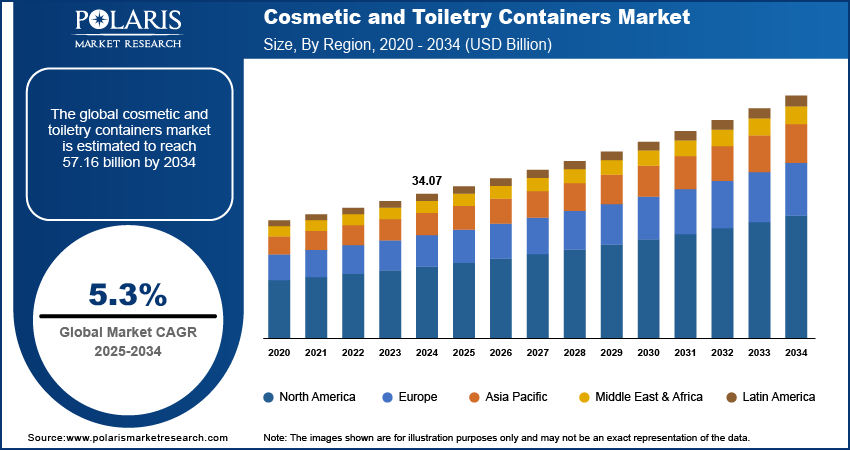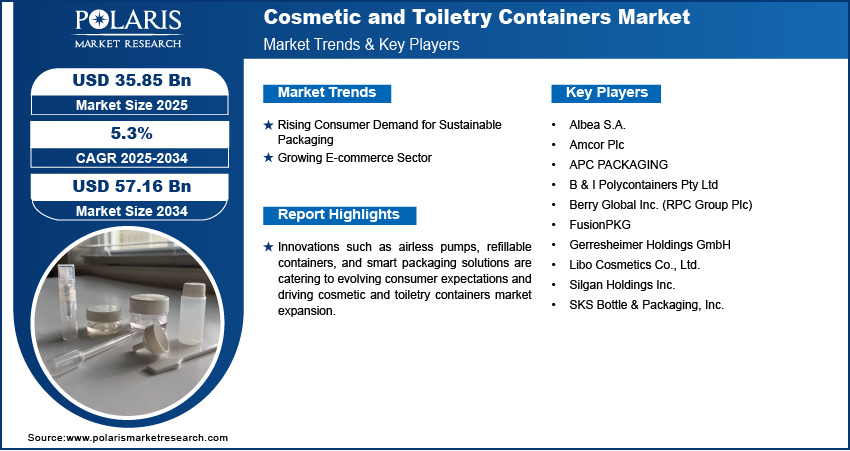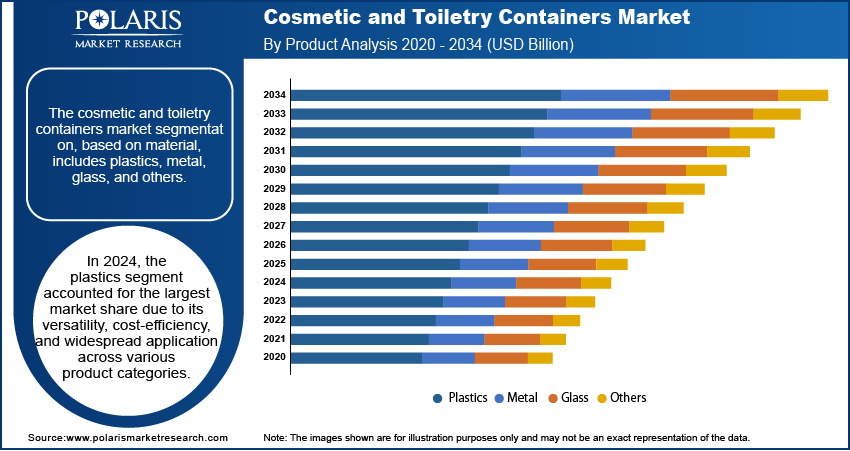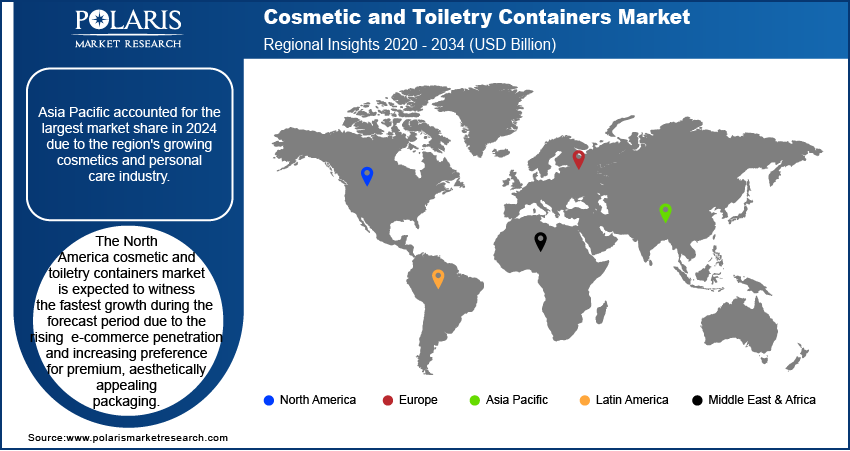
Cosmetic and Toiletry Containers Market Size, Share, Trends, Industry Analysis Report: By Material (Plastics, Metal, Glass, and Others), Product, and Region (North America, Europe, Asia Pacific, Latin America, and Middle East & Africa) – Market Forecast, 2025– 2034
- Published Date:Apr-2025
- Pages: 129
- Format: PDF
- Report ID: PM5464
- Base Year: 2024
- Historical Data: 2020-2023
Cosmetic and Toiletry Containers Market Overview
The global cosmetic and toiletry containers market size was valued at USD 34.07 billion in 2024. The market is expected to grow from USD 35.85 billion in 2025 to USD 57.16 billion by 2034, exhibiting a CAGR of 5.3% from 2025 to 2034.
The cosmetic and toiletry containers market encompasses the production, design, and distribution of packaging solutions specifically tailored for cosmetic and personal care products, including bottles, jars, tubes, and dispensers. These containers are designed to preserve product integrity, ensure ease of use, and enhance aesthetic appeal, playing a critical role in product differentiation and brand positioning in the competitive personal care industry.
The expansion of the premium cosmetics segment is fueling the demand for high-quality, aesthetically appealing containers that enhance product value and branding, thereby propelling the cosmetic and toiletry containers market growth. Moreover, innovations such as airless pumps, refillable containers, and smart packaging solutions are catering to evolving consumer expectations and driving market expansion.

To Understand More About this Research: Request a Free Sample Report
Brands are adopting customized packaging solutions to create unique identities, driving the demand for containers with tailored designs, shapes, and materials. Furthermore, the rising usage of skincare products, along with a growing focus on hygiene and self-care, is boosting the market demand for diverse container solutions to meet various product needs.
Cosmetic and Toiletry Containers Market Dynamics
Rising Consumer Demand for Sustainable Packaging
Growing awareness of environmental sustainability is driving demand for eco-friendly packaging solutions, including recyclable, biodegradable, and reusable container materials. To support this shift, brands are adopting sustainable packaging to meet consumer preferences and comply with regulations. For example, in January 2024, Amorepacific launched the ‘AMORE:CYCLE’ campaign for on- and offline container collection. This trend is expanding the market for eco-conscious products and encouraging innovation in materials like plant-based plastics and compostable packaging. As more consumers choose environmentally friendly options, the demand for sustainable cosmetic and toiletry containers continues to grow. This growing focus on green packaging is shaping the future of the cosmetic and toiletry containers market.
Growing E-commerce Sector
The rapid expansion of online shopping is driving the need for durable and visually appealing packaging. For instance, data from the European Union indicated that cosmetic and beauty products ranked as the third most commonly purchased category among EU online consumers in 2023, capturing 18% of total online shopping transactions within the region. Products are increasingly being shipped across long distances, driving the need for containers that can withstand the rigors of logistics while maintaining their aesthetic appeal. This shift is encouraging brands to innovate and invest in high-quality, protective materials that enhance customer satisfaction and product safety. Additionally, the emphasis on visually striking designs to capture consumer attention in digital marketplaces is fueling the cosmetic and toiletry containers market expansion, reinforcing the importance of packaging that balances functionality, durability, and visual appeal in the competitive online retail landscape.

Cosmetic and Toiletry Containers Market Segment Insights
Cosmetic and Toiletry Containers Market Assessment by Material Outlook
The global cosmetic and toiletry containers market segmentation, based on material, includes plastics, metal, glass, and others. In 2024, the plastics segment accounted for the largest market share due to its versatility, cost-efficiency, and widespread application across various product categories. Plastics offer unmatched design flexibility, enabling manufacturers to create lightweight, durable, and customizable packaging solutions that cater to diverse consumer preferences. The growing adoption of advanced plastic technologies, such as bio-based and recycled plastics, aligns with the increasing demand for sustainable packaging. Additionally, the ability of plastics to preserve product integrity while offering attractive designs for branding contributes significantly to their dominance in the market.
Cosmetic and Toiletry Containers Market Evaluation by Product Outlook
The global cosmetic and toiletry containers market segmentation, based on product, includes bottles, tubes, and others. The bottles segment accounted for the largest market share in 2024 due to their practicality, ease of use, and ability to securely store liquid and semi-liquid formulations. Bottles remain a preferred choice for packaging a wide range of products, including shampoos, lotions, and cleansers, due to their convenience for both consumers and manufacturers. Their compatibility with various materials, such as glass, plastic, and aluminum, enhances their appeal in the market. Furthermore, the growing trend of innovative bottle designs with features like pumps, sprays, and tamper-evident contributes to the segment’s leading position in the market.

Cosmetic and Toiletry Containers Market Regional Analysis
By region, the study provides the cosmetic and toiletry containers market insights into North America, Europe, Asia Pacific, Latin America, and the Middle East & Africa. In 2024, Asia Pacific accounted for the largest market share due to the region's growing cosmetics and personal care industry, driven by rising disposable incomes, urbanization, and increasing beauty consciousness among consumers. For instance, according to the India Brand Equity Foundation, the Indian skin care product market was valued at approximately USD 6.53 billion in 2022. Projections indicate that this market will grow to an estimated USD 8.86 billion by 2027, reflecting a robust compound annual growth rate (CAGR) as consumer demand for advanced and personalized skin care solutions continues to rise. The expansion of regional manufacturing capabilities, coupled with the availability of cost-effective raw materials, supports market growth. Furthermore, the growing demand for innovative and sustainable packaging solutions, fueled by heightened environmental awareness in countries like China, India, and Japan, significantly contributes to the market value.
The North America cosmetic and toiletry containers market is expected to witness the fastest growth during the forecast period due to the rising e-commerce penetration and increasing preference for premium, aesthetically appealing packaging. Consumer demand for eco-friendly and recyclable containers is driving innovation and market expansion. In addition, the region’s strong emphasis on regulatory compliance and sustainable manufacturing practices is contributing to the regional market growth. For instance, in November 2024, The U.S. EPA released the National Strategy to Prevent Plastic Pollution to reduce plastic waste, protect communities, and support a circular economy. It emphasizes regulations, industry accountability, and international cooperation.. This initiative addresses the challenges of plastic waste through regulatory measures, improved waste management, and innovative materials science. Key focuses include reducing single-use plastics, enhancing recycling and reuse, and investing in biodegradable alternatives. Moreover, rapid advancements in packaging technologies are creating growth opportunities in the regional market.

Cosmetic and Toiletry Containers Market – Key Players and Competitive Insights
The competitive landscape of the cosmetic and toiletry containers market is marked by the presence of several established players and emerging companies competing on innovation, sustainability, and customization. Leading manufacturers are focusing on developing eco-friendly packaging solutions, such as biodegradable, recyclable, and reusable materials, to meet the growing demand for sustainable options. Companies are investing in advanced manufacturing technologies, including 3D printing and smart packaging, to enhance product design and functionality. Strategic initiatives such as mergers and acquisitions, and partnerships are prevalent, enabling market expansion and portfolio diversification. Furthermore, customization capabilities, such as tailored designs and branding options, are being increasingly emphasized to cater to the specific needs of cosmetic brands, fueling market competition.
The market also experiences intense competition from regional players who focus on specific geographic areas, driving innovation and market demand with locally tailored solutions. The dynamic competitive landscape is further influenced by regulatory changes, as companies must comply with stringent standards such as FDA and ISO certifications for medical-grade materials. This competition is pushing companies to continuously innovate and provide more efficient, cost-effective solutions.
Albéa S.A. is a global provider of packaging solutions for the beauty, personal care, oral care, and pharmaceutical industries. The company specializes in designing and manufacturing a wide range of cosmetic and toiletry containers, including jars, tubes, lipsticks, mascaras, and pumps. Albéa emphasizes sustainable and innovative packaging solutions, offering recyclable and eco-friendly materials to meet growing market demand for environmentally responsible products. The company has a presence in over 20 countries and multiple production facilities, serveing cosmetic and toiletry brands worldwide.
Amcor Plc is engaged in packaging solutions, catering to industries such as personal care, healthcare, food, and beverages. The company offers a diverse portfolio of packaging options, including rigid and flexible packaging tailored to the market. Amcor’s personal care division provides high-performance solutions like PET bottles, tubes, and jars designed for durability and visual appeal, aligning with market demand for sustainable and premium packaging. The company operates in over 40 countries and focuses on incorporating recyclable and lightweight materials to support sustainability goals.
List of Key Companies in Cosmetic and Toiletry Containers Market
- Albea S.A.
- Amcor Plc
- APC PACKAGING
- B & I Polycontainers Pty Ltd
- Berry Global Inc. (RPC Group Plc)
- FusionPKG
- Gerresheimer Holdings GmbH
- Libo Cosmetics Co., Ltd.
- Silgan Holdings Inc.
- SKS Bottle & Packaging, Inc.
Cosmetic and Toiletry Containers Industry Developments
In October 2024, Silgan Holdings Inc. completed the acquisition of Weener Plastics Holdings B.V., strategically strengthening its portfolio in sustainable rigid packaging. This acquisition allows Silgan to integrate Weener's advanced dispensing technologies, specifically designed for applications in the personal care, food, and healthcare markets, thus enhancing its capabilities in delivering innovative and sustainable packaging solutions.
In January 2024, Berlin Packaging, Packaging Supplier worldwide, acquired Nest-Filler PKG Co., Ltd., a packaging provider specializing in beauty and cosmetic products.
In March 2024, GEKA launched its first ever formulation of recycled polypropylene that meets the stringent compliance standards for cosmetics packaging. According to GEKA, this innovative material represents a significant advancement in sustainable packaging solutions within the cosmetics industry, offering both performance and environmental responsibility.
Cosmetic and Toiletry Containers Market Segmentation
By Material Outlook (Revenue, USD Billion, 2020–2034)
- Plastics
- Metal
- Glass
- Others
By Product Outlook (Revenue, USD Billion, 2020–2034)
- Bottles
- Tubes
- Others
By Regional Outlook (Revenue, USD Billion, 2020–2034)
- North America
- US
- Canada
- Europe
- Germany
- France
- UK
- Italy
- Spain
- Netherlands
- Russia
- Rest of Europe
- Asia Pacific
- China
- Japan
- India
- Malaysia
- South Korea
- Indonesia
- Australia
- Vietnam
- Rest of Asia Pacific
- Middle East & Africa
- Saudi Arabia
- UAE
- Israel
- South Africa
- Rest of Middle East & Africa
- Latin America
- Mexico
- Brazil
- Argentina
- Rest of Latin America
Cosmetic and Toiletry Containers Market Report Scope
|
Report Attributes |
Details |
|
Market Size Value in 2024 |
USD 34.07 billion |
|
Market Size Value in 2025 |
USD 35.85 billion |
|
Revenue Forecast by 2034 |
USD 57.16 billion |
|
CAGR |
5.3% from 2025 to 2034 |
|
Base Year |
2024 |
|
Historical Data |
2020–2023 |
|
Forecast Period |
2025–2034 |
|
Quantitative Units |
Revenue in USD billion, and CAGR from 2025 to 2034 |
|
Report Coverage |
Revenue Forecast, Market Competitive Landscape, Growth Factors, and Trends |
|
Segments Covered |
|
|
Regional Scope |
|
|
Competitive Landscape |
|
|
Report Format |
|
|
Customization |
Report customization as per your requirements with respect to countries, regions, and segmentation. |
FAQ's
The global cosmetic and toiletry containers market size was valued at USD 34.07 billion in 2024 and is projected to grow to USD 57.16 billion by 2034.
The global market is projected to register a CAGR of 5.3% during the forecast period.
In 2024, Asia Pacific accounted for the largest market share due to the region's growing cosmetics and personal care industry.
Some of the key players in the market are Albea S.A.; Amcor Plc; APC PACKAGING; B & I Polycontainers Pty Ltd; Berry Global Inc. (RPC Group Plc); FusionPKG; Gerresheimer Holdings GmbH; Libo Cosmetics Co., Ltd.; Silgan Holdings Inc.; and SKS Bottle & Packaging, Inc.
In 2024, the plastics segment accounted for the largest market share due to its versatility, cost-efficiency, and widespread application across various product categories.
In 2024, the bottles segment held the largest market share due to their practicality, ease of use, and ability to securely store liquid and semi-liquid formulations.
